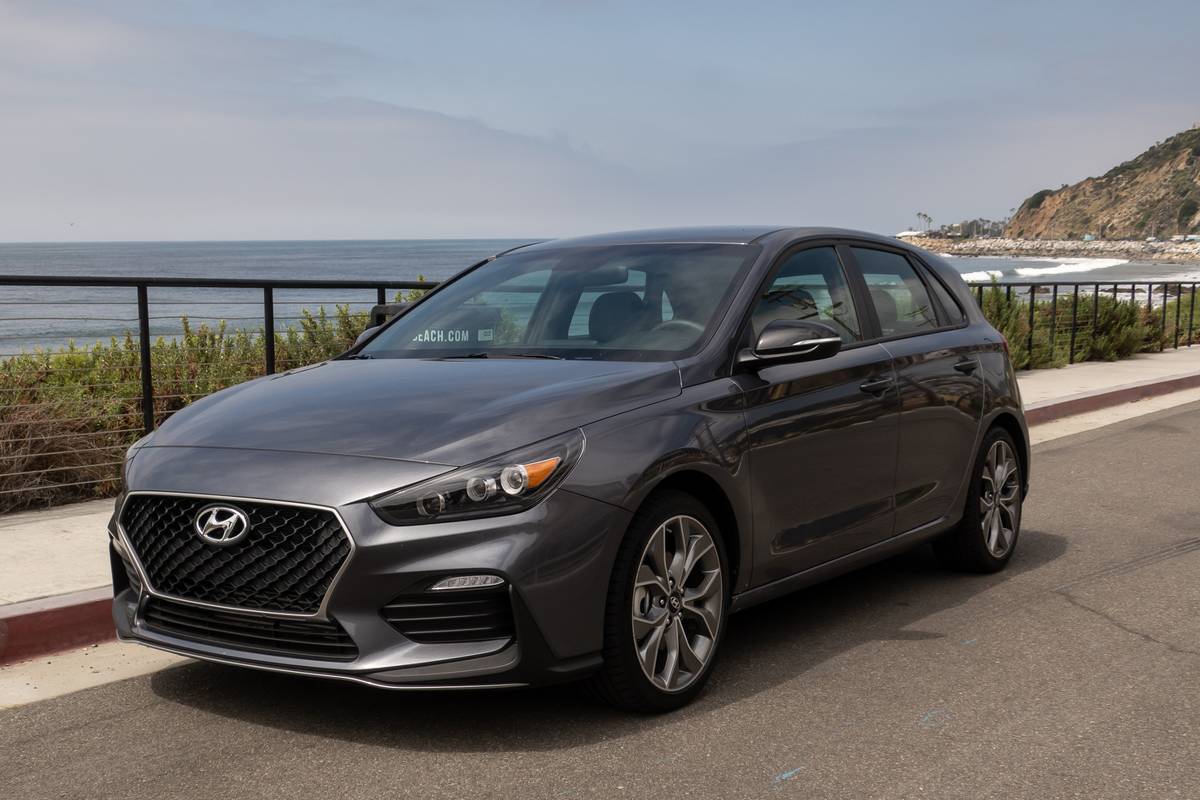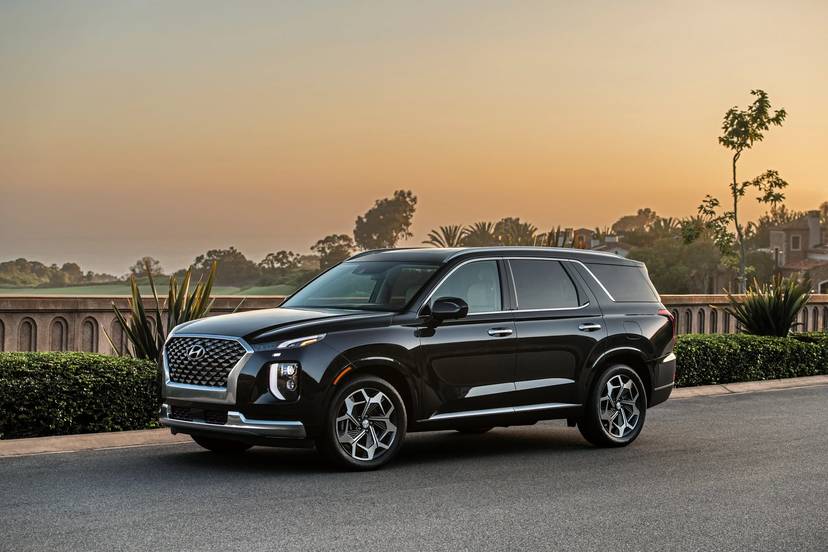
At first glance, the 2019 Hyundai Elantra GT N-Line doesn’t look like much. That’s mostly because it looks pretty much like your run-of-the-mill Elantra GT — which isn’t the most exciting thing when it comes to styling. Sitting still, it sort of screams practicality but in a fussy way, not in a fun way (like, say, the Kia Soul).
Related: Hyundai Kicks Off Sportier N Line Models With 2019 Elantra GT
But the Elantra GT N-Line isn’t so stodgy when you get behind the wheel because it holds a secret under the hood. And if you peek at the wheels closely, you’ll see they come wrapped in Michelin Pilot Sport 4 summer tires, which come along with a tidy, standard six-speed manual transmission. This combination — along with a slew of suspension updates and increased stiffness (especially to control body roll) — gives the hatchback a big scoop of fun that I investigated on the canyon roads around Malibu, Calif.
Good Under the Hood
The Elantra GT N-Line has a 201-horsepower, turbocharged 1.6-liter four-cylinder engine mated to a standard six-speed manual or optional seven-speed dual-clutch automatic ($1,100). For me, the manual transmission is the way to go. Not only is it a pretty good manual, it’s also the only way to get the summer tires. That way you get to row your own gears and get more grip in the bargain.
A well-suited companion for the car, this engine makes it feel quick and light, but in a controllable way. With the manual, it’s easy to keep the engine in its sweet spot, which ends up being fairly low in the rev range: By about 3,000 rpm, the Elantra GT N-Line is humming along pretty well, and any small throttle input at that point translates quickly into forward motion.
If this sounds familiar, it’s because the redesigned Hyundai Veloster also features a turbocharged 1.6-liter four-cylinder that makes identical power numbers. There are some differences between the engines, however: The one in the Veloster has a higher compression ratio and different electronic control unit tuning that dials it up even more. But I found the drivetrain in the Elantra GT N-Line to fit that car better since it’s less of a performance-focused vehicle. How can you tell? The Veloster comes with a few key features missing from the Elantra GT N-Line that would make a big difference, starting with a torque-vectoring control system.
One Thing Missing
The suspension updates do a good job of keeping the Elantra GT N-Line sorted in the bends; there’s a bit of body roll, but it feels controlled. I like a bit of body roll in a car like this — the feedback helps you feel for the car’s limit and keep it under control. The summer tires also provide a lot of grip; they do feel in some ways overqualified versus the rest of the car, but I’m not complaining.
Problems arise once you get on the power. If you really get into the accelerator pedal (especially in 2nd gear), there’s a good amount of torque steer, which you immediately feel through the steering wheel. It happens if you’re trying to punch it in a straight line, but it becomes most apparent trying to apply power on corner exits. The wheels start to hop and chirp as you roll onto the gas, so you have to be extra careful to get the car rebalanced before adding speed back on.
Here is where the Elantra GT N-Line in some ways illustrates the difference between a good car and a fun car. There’s a weird sort of amusement that comes from the Elantra GT N-Line’s torque steer, which rears its head unpredictably and keeps you on your toes. It’s like when a pitcher in baseball throws really hard but doesn’t have much command: Anything could happen, which is exciting but also a little scary.
Contrast this with the Veloster R-Spec, which would fall more on the side of a good car (while still being fun enough in its own right). It is more proficient at both accelerating and going around corners thanks to its torque-vectoring system, which works to prevent torque steer and wheel hop. The Elantra GT N-Line sort of splits the difference; it’s got a performance engine but not the other mechanical bits to match, and it comes up short of being a true performance hatchback for this reason. It would be a stretch to say it’s very good, but I will readily admit that I had a pretty damn good time driving it around.
More from Cars.com:
- Hyundai Tucson N Line Stays in Line With Sporty-Styled Siblings
- 2019 Hyundai Veloster N Vs. Veloster R-Spec: Smiles Per Dollar Compared
- Is the 2019 Hyundai Veloster the Most Fun You Can Have for $24,000?
- Research the 2019 Hyundai Elantra GT
What About Competitors?
The Veloster R-Spec is a natural competitor from Hyundai’s own garage, but I think the two cars have different aims. The R-Spec is a better performer, but it’s got only three doors and a dinky backseat; by contrast, the Elantra GT N-Line is much better at double duty as a practical hatchback with some whimsy added on.
My test vehicle stickered at $24,300 (including destination charges). That puts it right within range of the 2019 Honda Civic Si sedan. The Civic Si sedan costs about $1,000 more ($25,220) — and yes, I’m comparing only to the sedan version of that car because Honda refuses to make a hatchback version of it, which I would love.
There’s a lot of similarity between the two vehicles: The Civic Si’s turbocharged four-cylinder engine makes a touch more horsepower (205 versus 201) and it’s positioned similarly as a performance-focused variant. But the Civic Si also offers two features that make it a better performer than the Elantra GT N-Line in my mind: a limited slip-differential up front and an adaptive suspension. The Civic Si when flipped into Sport mode is a significantly sharper instrument; the tighter suspension and the ability to put down power sans torque steer make it much more confident when you’re moving quickly, and I’d also give it the edge in steering feel.
But it isn’t a hatchback, so the Elantra GT N-Line takes the edge on practicality. It’s got a much bigger cargo area, more headroom for passengers and if you drop the rear seats, you can fit a lot of stuff in its 55.1 cubic feet of cargo room.
I came away from the Elantra GT N-Line quite happy with it. It’s the first of Hyundai’s N-Line cars, but it won’t be the last and I’m glad to find that it isn’t just a gussied-up trim package with no real performance gains — the additional power and beefed-up suspension components are a good omen for the next models to come, which will include the Tucson N-Line that was introduced at the Geneva motor show in March.
Cars.com’s Editorial department is your source for automotive news and reviews. In line with Cars.com’s long-standing ethics policy, editors and reviewers don’t accept gifts or free trips from automakers. The Editorial department is independent of Cars.com’s advertising, sales and sponsored content departments.

























































